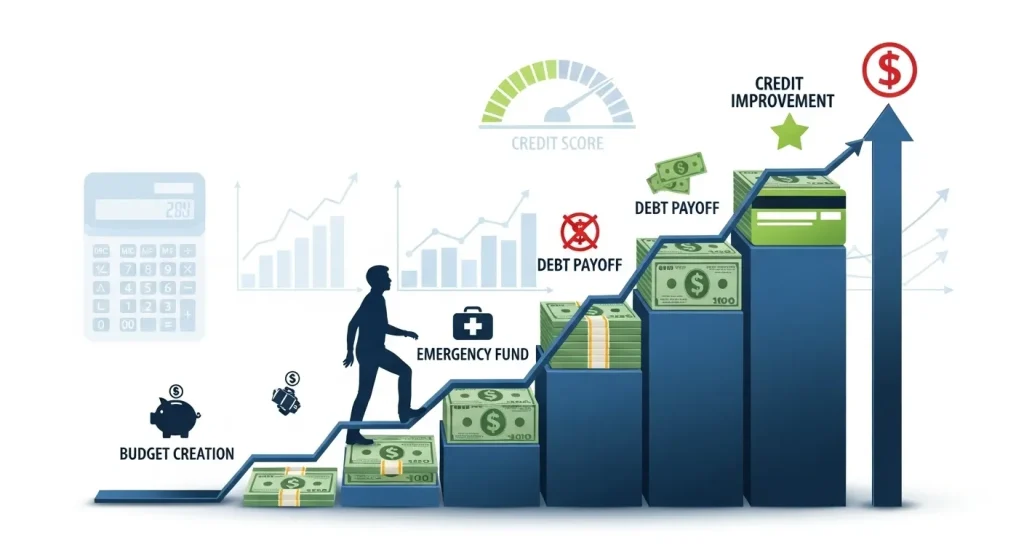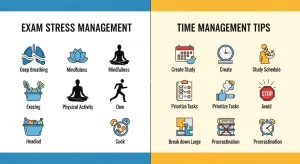Managing debt and maintaining good credit has become increasingly challenging in today’s economic landscape. With 45% of credit card debtors attributing their debt to emergency or unexpected expenses, effective debt management strategies are more crucial than ever. This comprehensive guide provides expert credit advice to help you regain control of your finances and build a stronger financial future.
Side Hustles & Passive Income: Build Wealth
Understanding Debt Management: The Foundation of Financial Health
Debt management involves creating a structured approach to paying off what you owe while maintaining your ability to meet daily expenses. Effective debt management isn’t just about making minimum payments—it’s about developing a strategic plan that reduces your overall debt burden and improves your credit standing.
The Current State of Consumer Debt
The financial landscape has evolved significantly, with new challenges emerging for consumers. Modern debt management requires understanding various debt types, from credit cards to student loans, and how they impact your overall financial picture. Smart credit advice starts with acknowledging that debt isn’t inherently bad—it’s how you manage it that matters.
Essential Debt Management Strategies That Actually Work
1. The Debt Avalanche Method
This debt payoff strategy focuses on paying minimum amounts on all debts while directing extra funds toward high-interest debt first. This approach saves the most money in interest payments over time, making it a cornerstone of effective debt management.
How to implement:
- List all debts with interest rates
- Pay minimums on everything
- Apply extra payments to highest-rate debt
- Once paid off, move to next highest rate
2. Debt Consolidation: Simplifying Your Financial Life
Debt consolidation can be a powerful tool in your debt management arsenal. This strategy involves combining multiple debts into a single payment, often at a lower interest rate.
Types of debt consolidation:
- Balance transfer credit cards
- Personal consolidation loans
- Home equity loans or lines of credit
- Debt management plans through credit counseling
3. The Snowball Method: Building Momentum
While the avalanche method saves more money, the snowball method—paying off smallest debts first—provides psychological wins that keep you motivated throughout your debt management journey.
Complete Guide to Investing & Retirement Planning
Credit Repair: Rebuilding Your Financial Reputation
Credit repair goes hand-in-hand with debt management. Your credit score affects everything from loan approvals to insurance rates, making credit score improvement essential for long-term financial health.
DIY Credit Repair Steps
- Obtain Your Credit Reports
- Get free reports from all three bureaus annually
- Review for errors, outdated information, or inaccuracies
- Document any discrepancies you find
- Dispute Inaccuracies
- File formal disputes with credit bureaus
- Provide supporting documentation
- Follow up on dispute resolutions
- Address Outstanding Debts
- Negotiate payment plans with creditors
- Consider pay-for-delete agreements
- Prioritize recent negative items
Professional Credit Repair Services
While DIY credit repair is possible, professional services can provide valuable expertise. Modern credit repair now combines AI-driven personalization with transparent workflows, offering more than quick fixes. When choosing a service, look for:
- Transparent pricing structures
- Money-back guarantees
- Positive customer reviews
- Clear explanation of services provided
Essential Budgeting & Saving Strategies
Building a Comprehensive Financial Plan
Emergency Fund Development
Before aggressive debt payoff, establish a small emergency fund ($500-$1,000). This prevents new debt accumulation when unexpected expenses arise—remember, emergency expenses are responsible for 45% of credit card debt.
Budgeting for Debt Freedom
Effective debt management requires a realistic budget that:
- Accounts for all income sources
- Lists every expense category
- Identifies areas for cost reduction
- Allocates specific amounts for debt payments
Creating Multiple Income Streams
Consider supplementing your income to accelerate debt payoff:
- Freelance work in your skill area
- Part-time employment
- Selling unused items
- Gig economy opportunities
Advanced Credit Score Improvement Techniques
Optimizing Credit Utilization
Keep credit card balances below 30% of available limits, ideally under 10%. This simple strategy can significantly impact your credit score improvement efforts.
Strategic Account Management
- Keep old accounts open to maintain credit history length
- Use cards occasionally to keep accounts active
- Request credit limit increases when appropriate
- Consider becoming an authorized user on family accounts
Timing Your Applications
Space out credit applications to minimize impact on your score. Multiple inquiries in a short period can lower your score temporarily.
Sleep Improvement & Relaxation: Your Complete Guide to Better Rest
Technology and Debt Management in 2025
Artificial Intelligence and machine learning are becoming central to credit scoring, with traditional models being augmented with AI tools that assess financial behaviors beyond basic payment history. This evolution means:
- More personalized credit advice through AI platforms
- Enhanced debt management apps with predictive analytics
- Improved credit repair tools that identify optimization opportunities
- Real-time monitoring and alerts for credit changes
Common Debt Management Mistakes to Avoid
- Only Making Minimum Payments
- Extends repayment time significantly
- Increases total interest paid
- Slows credit score improvement
- Ignoring High-Interest Debt
- Credit cards often carry the highest rates
- Payday loans can trap borrowers in cycles
- Store credit cards typically have poor terms
- Not Addressing Credit Report Errors
- Errors are surprisingly common
- Can significantly impact credit scores
- Simple disputes can improve scores quickly
- Taking on New Debt During Payoff
- Undermines progress
- Can lead to overwhelming debt loads
- Makes debt management more complex
Ultimate Guide to Home Workout Routines: Build Strength at Home
When to Seek Professional Help
Consider professional credit counseling or debt relief services when:
- You’re consistently unable to make minimum payments
- Debt stress is affecting your mental health
- You’re considering bankruptcy
- DIY efforts haven’t produced results after 6-12 months
Reputable nonprofit credit counseling agencies can provide:
- Free or low-cost consultations
- Debt management plan creation
- Budgeting assistance
- Credit advice tailored to your situation
Frequently Asked Questions
How long does debt management typically take?
The timeline for successful debt management varies greatly depending on total debt amount, available income for payments, and chosen strategy. Most people see significant progress within 2-5 years with consistent effort. Credit score improvement can begin within 30-60 days of implementing proper strategies.
Can I do credit repair myself, or do I need professional help?
DIY credit repair is absolutely possible and often effective. You can dispute errors, negotiate with creditors, and implement credit score improvement strategies independently. Professional services are helpful when you lack time, knowledge, or are dealing with complex situations. The choice depends on your comfort level and specific circumstances.
What’s the difference between debt consolidation and debt settlement?
Debt consolidation combines multiple debts into one payment, typically at a lower interest rate, without reducing the total amount owed. Debt settlement involves negotiating to pay less than the full amount owed, which can severely impact your credit score. Consolidation is generally the better option for debt management unless you’re facing severe financial hardship.
Healthy Breakfast Ideas for Busy Mornings
Take Control of Your Financial Future Today
Effective debt management and credit repair require commitment, patience, and the right strategies. Start by assessing your current situation, creating a realistic plan, and taking consistent action toward your goals. Remember, small steps taken consistently lead to significant improvements in your financial health.
Ready to transform your financial situation? Get personalized debt management solutions and expert credit advice with our recommended financial planning tools.
Here are 5 Amazon affiliate products perfect for your debt management and credit advice blog post:
1. Personal Finance Books
- Product: “Total Money Makeover” by Dave Ramsey
- Why it fits: Essential reading for debt payoff strategies
- Placement: In the “Debt Management Strategies” section
- Anchor text: “proven debt elimination methods”
2. Budget Planner/Organizer
- Product: Simplified Budget Planner – Financial Organizer
- Why it fits: Physical tool for tracking debt payoff progress
- Placement: In the “Building a Comprehensive Financial Plan” section
- Anchor text: “track your debt management journey”
3. Credit Monitoring Service
- Product: Identity Guard Credit Monitoring (via Amazon)
- Why it fits: Essential for credit repair and monitoring
- Placement: In the “Credit Repair” section
- Anchor text: “monitor your credit score improvement”
4. Financial Calculator
- Product: Texas Instruments BA II Plus Financial Calculator
- Why it fits: Calculate debt payoff scenarios and interest
- Placement: In the “Debt Consolidation” section
- Anchor text: “calculate your debt consolidation savings”
5. Personal Finance Software
- Product: Quicken Premier Personal Finance Software
- Why it fits: Comprehensive debt and credit management tool
- Placement: In the “Technology and Debt Management” section
- Anchor text: “streamline your financial planning”
Integration Tip: Place these naturally within the content as helpful resources rather than obvious sales pitches. Each should solve a specific problem mentioned in that section of your blog post.
Call to Action: Take the first step toward financial freedom today. Start with a free credit report review and begin your journey to better debt management and improved credit health.











